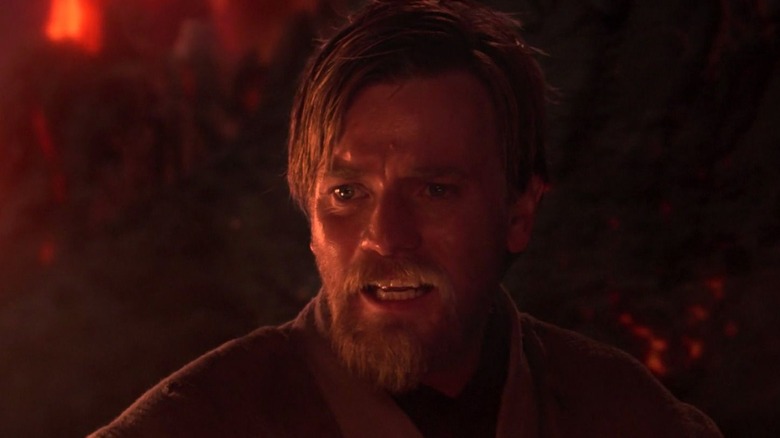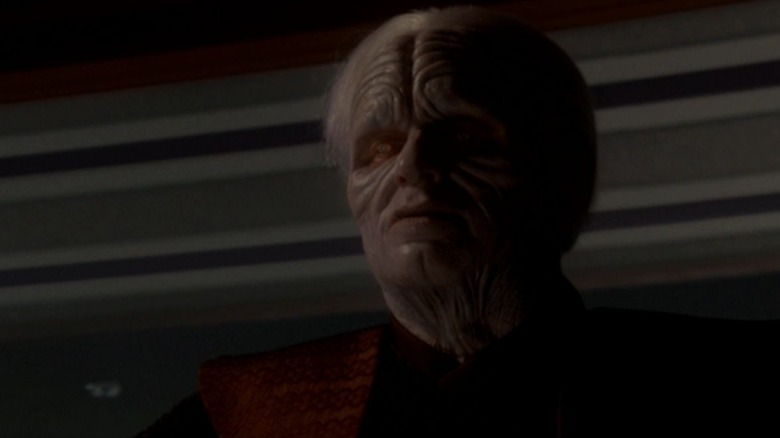George Lucas Took A Lax Approach To Continuity In Star Wars: Revenge Of The Sith
One might notice little odd camera tricks and visual continuity errors throughout all the "Star Wars" movies if one looks closely enough. For instance, there is a scene in George Lucas' "Star Wars: Episode III – Revenge of the Sith" wherein Obi-Wan Kenobi (Ewan McGregor) is about to fight the evil robotic lizard General Grievous (Matthew Wood). Grievous first tries to send a few attack droids after Obi-Wan, but the Jedi uses his mental powers to pull a large object from the ceiling and send it crashing onto their heads. Grievous and Obi-Wan proceed to have a proper lightsaber fight. One might notice, though, that the crushed droids and the large chunk of ceiling are nowhere to be seen. Clearly, the filmmakers didn't bother to invent a reason why those things were gone.
In the same film, before Obi-Wan is about to face Anakin (Hayden Christensen) on the volcano planet Mustafar, he removes his robe and drops it to the ground in the middle of a ramp. In a reverse shot, the robe is pushed to the side of the ramp.
These sorts of minor errors will only be noticed by stringent continuity hawks and impressively athletic nitpickers (which are, I proudly declare, a vital part of any fan community). They're also more likely throughout cinema than one might realize. Indeed, if pressed, many filmmakers may admit that small continuity errors of this nature are not terribly important. If the shot looks good and the pace of a scene is not interrupted, then little visual errors of the above nature can be roundly ignored.
In J.W. Rinzler's 2005 book "The Making of Star Wars: Revenge of the Sith," Lucas pretty much said that out loud. Close enough, he feels, is close enough.
Continuity is for wimps
A production diary in the book recalls who came to visit the set and what Lucas was working on any given day. On January 20, 2004, Lucas got to meet with Katsuhiro Otomo, the celebrated animator and director of "Akira," as Otomo was using the facilities of Lucas' Skywalker Sound to complete his latest picture "Mushishi." The diary also noted that Lucas was, that same day, examining the landing platforms on the above-mentioned Mustafar, making sure that the spaceships took off and landed in an interesting and visually dynamic fashion. He noted that some of the shots he was planning mildly contradicted others that he also preferred. But he laid out his philosophy pretty plainly, being quoted as saying:
"The most important thing is to make the landings look good. Then once we get down there, the geography just has to be mostly right. [...] Continuity is for wimps."
Given the way "Revenge of the Sith" was filmed — a lot of static shots in closed-in interiors, punctuated by vast, glorious CGI vistas — Lucas needed his outdoor action to look as dazzling as possible. Many of the interior scenes were merely two characters, usually against a green screen, talking on a couch or talking in an office. Lucas noted himself, "You just don't get the camera way back very often. Everything else is talking heads against backgrounds. So every wide shot is a signature shot."
Worrying about the vast visual geography of a scene wasn't so important as getting said "signature shot." Was Samuel L. Jackson a few steps away from Palpatine in that one shot, only to be closer in the next shot? Yeah, probably, but who cares? There's action to do.

